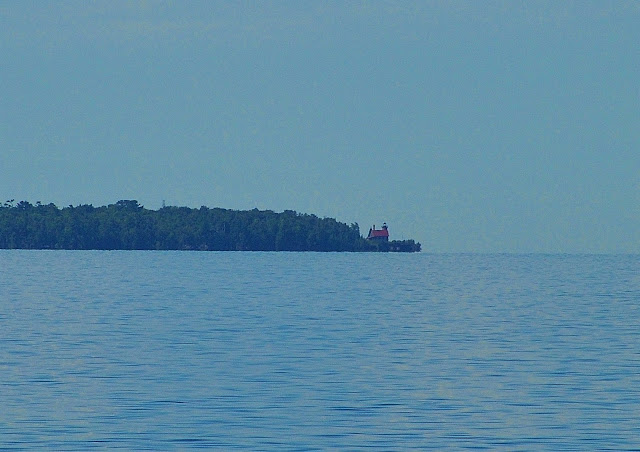( NOTE: QUALITY IS GREATLY DIMINISHED DUE TO THE APPROXIMATE 5 MILES IN DISTANCE FROM WHERE PHOTOGRAPHED)
Sand Island Lighthouse in 1913
Photograph courtesy from the U.S. Coast Guard
In 1871, the Lighthouse Board requested funds to establish lights on Outer Island and Sand Island to mark, respectively, the eastern and western end of the Apostle Islands. Lighthouses had earlier been established on Michigan Island, Long Island, and Raspberry Island to help vessels navigate through the islands, but b y this time most maritime traffic was bypassing the islands, headed for the booming port at Duluth, Minnesota.Outer Island Lighthouse was activated in 1874, and three years later the Lighthouse Board renewed its plea for a light on Sand Island: Incoming from Duluth, the Raspberry Island light is not visible until abreast of Sand Island, and there being no coast light in this distance of 80 miles, causes much distress and danger to the increasing commerce of the west end of Lake Superior. An appropriation of $18,000 for the building of this station is recommended. " Congress finally funded the lighthouse in 1880, and work on the island commenced on June 6, 1881, under the supervision of Louis Charles Lederle. The plans for the lighthouse, a Norman Gothic design consisting of a tower rising from one corner of a one-and-a-half-story keeper’s dwelling, had been used elsewhere in the Great Lakes - Chambers Island and Eagle Bluff (1868), McGulpin’s Point (1869), Eagle Harbor and St. Clair Flats Canal (1871), and White River (1875) - but this would been the first time that sandstone was used rather than brick. On July 2, 1881, the Bayfield County Press noted the ongoing work on Sand Island. Sand Island. Supt. Lederle has cleared about ten acres of ground and opened a fine quarry of red sandstone which will be used for the government buildings. The Light House proper will be thirty-eight by twenty-eight feet in size, and the light will be places about fifty feet above the water level. No structure could have a more profound connection to its environment than the exquisite little lighthouse on Sand Island, constructed from the same stone as the promontory on which it sits. It is as if the builders simply reshaped the fabric of the island into lighthouse form. The dwelling’s gables feature gingerbread ornaments, and the tower transforms from a square in its lower half to an octagon in its upper half. A fourth-order, Henry-Lepaute Fresnel lens was installed atop the forty-two-foot tower and commenced showing a fixed white light on September 25, 1881. On April 23, 1921, an acetylene gas apparatus started emitting a white flash every ten seconds from the lantern room, and Sand Island became the first lighthouse in the Apostle Islands to be automated. Keepers at Raspberry Island subsequently kept an eye on the light. A forty-eight-foot, steel, skeletal tower was erected near Sand Island Lighthouse in 1933, and the light was transferred to it. The Coast Guard removed the steel tower in 1985 and returned the light to the lighthouse’s lantern room.




No comments:
Post a Comment